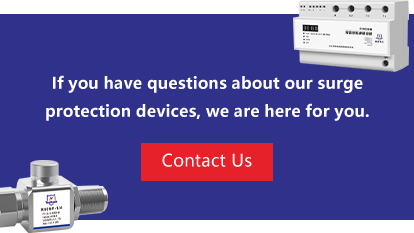Passive Protection Mechanism: SPDs rely on passive components (e.g., Metal Oxide Varistors (MOVs), gas discharge tubes) to suppress surges without requiring external power.
Self-Recovery Capability: For transient overvoltages (e.g., lightning strikes), SPDs
automatically reset to a high-impedance state after diverting the surge energy.
Key Limitations:
Cumulative Damage: Repeated high-energy surges degrade MOV performance (increased clamping voltage/slower response).
Sustained Overload Risk: Prolonged overvoltage (e.g., undetected voltage spikes) may cause overheating and failure.
The surge protector for sale is widely used in various electronic equipment, instruments and communication lines. They are suitable for AC 50/60HZ, rated voltage 220V/380V power supply systems (China), as well as various voltage systems in other countries. It is suitable for residential, tertiary and industrial fields, and can effectively protect power and signal systems from lightning strikes and other transient overvoltage surges1
| Failure Type | SPD Status Change | Post-Failure Functionality |
| Planned Outage (Maintenance) | No surge stress; SPD remains intact. | Fully operational |
| Transient Fault (Lightning) | SPD briefly conducts to dissipate energy, then self-resets. | Requires cumulative damage check |
Sustained Fault (Short-circuit/Overvoltage) | May trigger fuse tripping or SPD thermal damage. | Replacement needed |
Basic Type ( SPD module)
Single-stage MOV protection; remains functional post-outage if undamaged.
Risk : No fuse protection may lead to direct short-circuit during overload.
Backup-Protected Type/SSD (Circuit Breaker/Fuse Combo)
Fuse disconnects SPD during extreme surges.
Recovery: Requires manual fuse replacement/circuit breaker reset.
Smart Type (with Monitoring SPD):
Logs surge events but loses communication during prolonged outages.
Note: Core protection remains active if components are intact.
Parameter Mismatch
SPDs with maximum continuous operating voltage (Uc) lower than line voltage degrade faster.
Insufficient Insulation Coordination
Residual voltage post-surge may damage poorly insulated equipment.
Switch-On Surges
Power restoration spikes can fatally damage aged SPDs.
| Test Method | Procedure | Pass/Fail Criteria |
Visual Inspection | Check status LED (green=OK, red/off=failed) or color-changing window. | No indicator → Further testing |
| Multimeter Test | Measure MOV resistance (power off). | Significant drop/zero Ω = failed |
| Professional Evaluation | Use dedicated testers to verify clamping voltage/leakage current. | Parameters out of spec → Replace |
Regular Inspections
Mandatory after thunderstorms or major power disturbances.
Multi-Stage Protection
Deploy primary (first-level) SPD + secondary (cabinet) SPD + tertiary (outlet) SPD.
Parameter Matching
Ensure SPD’s Uc voltage and surge current rating (In/Imax) align with grid requirements.
Prompt Replacement
Replace failed SPDs or blown fuses immediately to avoid protection gaps.
Final Conclusion
Normal Conditions: SPDs self-recover after outages/transient faults.
Failure Conditions: Sustained overvoltage, fuse tripping, or parameter mismatch cause permanent failure.
Strategy: Combine visual checks + instrument testing, implement multi-stage protection, and ensure grid compatibility.
Appendix: SPD Lifecycle Management Flowchart
Power failure → Determine fault type (transient/sustained)
↓
Transient fault → SPD auto-resets → Log surge count → Periodic degradation checks
↓
Sustained fault → Inspect fuse/circuit breaker → Test SPD components → Replace damaged parts
Systematic maintenance ensures SPD reliability post-power failure.
 PC power supplies have built-in surge protection or not ? TECHWIN provides indispensable protectionMay 8, 2025PC power supplies (PSUs) typically include basic surge protection, but they are not designed to handle large power surges (e.g., lightning strikes or grid fluctuations) effectively. Here’s how Shenzh...view
PC power supplies have built-in surge protection or not ? TECHWIN provides indispensable protectionMay 8, 2025PC power supplies (PSUs) typically include basic surge protection, but they are not designed to handle large power surges (e.g., lightning strikes or grid fluctuations) effectively. Here’s how Shenzh...view Selection of Signal SPD Lightning Protection EquipmentMarch 13, 2023When it comes to the use of lightning arrester, many people lack a correct understanding of some of the parameters of the lightning arrester. Coupled with the increasing frequency of thunderstorms and...view
Selection of Signal SPD Lightning Protection EquipmentMarch 13, 2023When it comes to the use of lightning arrester, many people lack a correct understanding of some of the parameters of the lightning arrester. Coupled with the increasing frequency of thunderstorms and...view The imortant technical characteristics of SPDSeptember 8, 2021Maximum continuous operating voltage UCThe maximum continuous operating voltage (old: rated voltage) is the maximum root mean square value (rms) of the allowable voltage applied to both ends of the su...view
The imortant technical characteristics of SPDSeptember 8, 2021Maximum continuous operating voltage UCThe maximum continuous operating voltage (old: rated voltage) is the maximum root mean square value (rms) of the allowable voltage applied to both ends of the su...view How Does A Surge Protection Device Work?August 30, 20211. Learn what is a power surge before undersanding a surge protection deviceFirstly, you need to understand what a power surge is before understanding how a surge protection device works. When the vol...view
How Does A Surge Protection Device Work?August 30, 20211. Learn what is a power surge before undersanding a surge protection deviceFirstly, you need to understand what a power surge is before understanding how a surge protection device works. When the vol...view The Relationship Between Up and in in Surge Protector (SPD)July 8, 2022Shenzhen Techwin Lightning Technologies Co., Ltd has independently successfully developed a series of products: SPD surge protector, power surge protector, power surge protector, signal surge protecto...view
The Relationship Between Up and in in Surge Protector (SPD)July 8, 2022Shenzhen Techwin Lightning Technologies Co., Ltd has independently successfully developed a series of products: SPD surge protector, power surge protector, power surge protector, signal surge protecto...view Gigabit Ethernet Surge Protector: Safeguarding the Stable Operation of Smart Cities and Digital Monitoring SystemsApril 23, 2025As society continues to develop, smart cities and intelligent buildings are emerging everywhere like mushrooms after rain. We can see various digital network cameras standing on street corners, quietl...view
Gigabit Ethernet Surge Protector: Safeguarding the Stable Operation of Smart Cities and Digital Monitoring SystemsApril 23, 2025As society continues to develop, smart cities and intelligent buildings are emerging everywhere like mushrooms after rain. We can see various digital network cameras standing on street corners, quietl...view